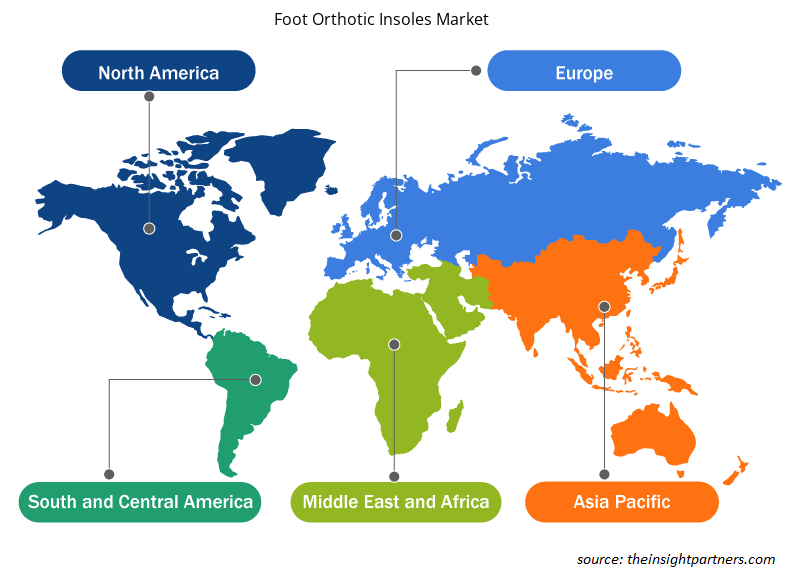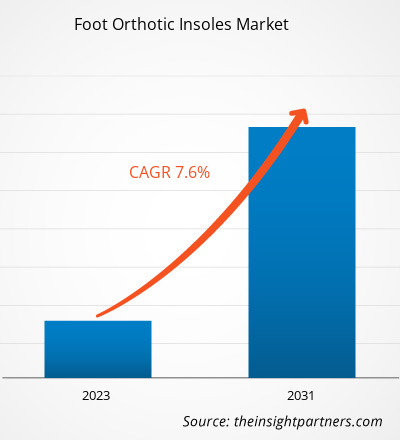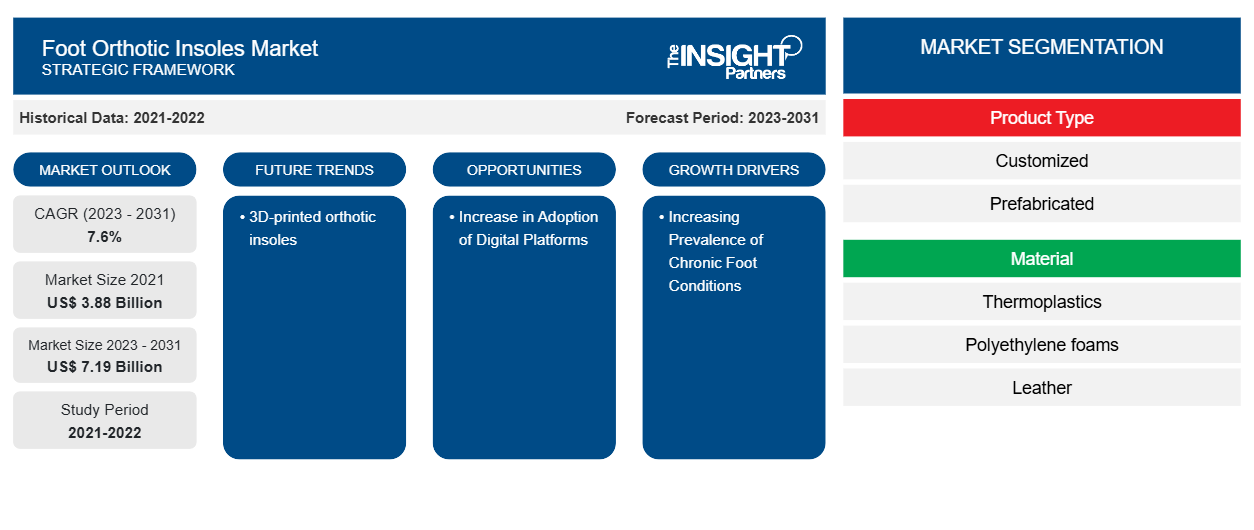Der Markt für orthopädische Einlegesohlen wurde im Jahr 2021 auf 3,88 Milliarden US-Dollar geschätzt und soll bis 2031 7,19 Milliarden US-Dollar erreichen. Der Markt soll im Zeitraum 2023–2031 eine durchschnittliche jährliche Wachstumsrate (CAGR) von 7,6 % verzeichnen. 3D-gedruckte orthopädische Einlegesohlen werden wahrscheinlich ein wichtiger Markttrend für orthopädische Einlegesohlen bleiben.
Marktanalyse für orthopädische Einlegesohlen
Fußorthesen oder Orthesen sind Vorrichtungen, die in die Schuhe eingesetzt werden und für eine Entlastung des Fußes und eine Polsterung sorgen. Vorgefertigte Fußorthesen, auch rezeptfrei oder rezeptfrei erhältlich, werden in Massenproduktion auf der Grundlage der Fußgröße hergestellt. Maßgefertigte Fußorthesen werden anhand eines Gipsabdrucks oder eines 3D-Laserscans des Fußes hergestellt und sind konfektionierte Vorrichtungen. Fußorthesen sind Teil der Standardbehandlung von Patienten mit Fuß- und Beinproblemen, darunter rheumatoide Arthritis, Plantarfasziitis, Pronationsfuß und Plantarfasziitis.
Marktübersicht für orthopädische Einlegesohlen
Das Wachstum wird durch die gestiegene Nachfrage nach auftragsgefertigten Fußorthesen vorangetrieben. Diese Materialien werden nach einer gründlichen Untersuchung der Fußstruktur des Benutzers auf Bestellung hergestellt . Maßgefertigte Orthesen bieten klinisch nachgewiesene Vorteile gegenüber vorgefertigten, darunter verbesserten Komfort und Schmerzlinderung. Endkunden verlangen immer mehr 3D-gedruckte Orthesen. Diese sind propriozeptiver und gangeffizienter als herkömmliche und ihr schlankeres Design treibt die Expansion des Marktes voran. Wichtige Unternehmen finanzieren auch kontinuierlich Forschungs- und Entwicklungsprojekte, um mithilfe des 3D-Drucks Einlegesohlen herzustellen, die besser passen und sich besser anfühlen. Im gesamten Prognosezeitraum werden sich auf dem Weltmarkt weitere Möglichkeiten für fußorthetische Einlegesohlen ergeben.
Passen Sie diesen Bericht Ihren Anforderungen an
Sie erhalten kostenlose Anpassungen an jedem Bericht, einschließlich Teilen dieses Berichts oder einer Analyse auf Länderebene, eines Excel-Datenpakets sowie tolle Angebote und Rabatte für Start-ups und Universitäten.
-
Holen Sie sich die wichtigsten Markttrends aus diesem Bericht.Dieses KOSTENLOSE Beispiel umfasst eine Datenanalyse von Markttrends bis hin zu Schätzungen und Prognosen.
Markttreiber und Chancen für orthopädische Einlegesohlen
Zunehmende Prävalenz chronischer Fußerkrankungen
Schätzungen zufolge leiden etwa 30,0 % der Menschen im Allgemeinen an Fußschmerzen. Diese Schmerzen können durch verschiedene Erkrankungen wie Schleimbeutelentzündung, Plantarfasziitis, Arthritis und diabetische Fußgeschwüre verursacht werden. Ärzte empfehlen daher zur Behandlung dieser Erkrankungen die Verwendung orthopädischer Einlegesohlen. Das NCBI prognostiziert, dass es im Jahr 2021 weltweit 9,1 bis 26,1 Millionen diabetische Fußgeschwüre geben wird. Darüber hinaus wird erwartet, dass 20 bis 25 % der Menschen mit Diabetes mellitus ein diabetisches Fußgeschwür entwickeln. Das Volumen und die Häufigkeit diabetischer Fußgeschwüre nehmen weltweit rapide zu, da die zunehmende Verbreitung der Krankheit epidemische Ausmaße angenommen hat. Daher sind die zuvor genannten Faktoren wichtige Wachstumstreiber für den globalen Markt.fasciitis, arthritis, and diabetic foot ulcers, can cause this pain. Therefore, to treat these conditions, physicians advise using foot orthotic insoles. The NCBI predicts that 2021, there will be 9.1 million to 26.1 million diabetic foot ulcers worldwide. Furthermore, 20 to 25 percent of people with diabetes mellitus are expected to experience the development of a diabetic foot ulcer. The volume and frequency of diabetic
Zunehmende Nutzung digitaler Plattformen – eine Chance auf dem Markt für medizinische sterile Tupfer
Eine Online-Plattform ermöglicht neuen Marktteilnehmern, ihre Produkte auf gleicher Augenhöhe zu vermarkten, und ermöglicht es Verbrauchern, aus verschiedenen verfügbaren Optionen auszuwählen und diese zu vergleichen. Die digitale Plattform erfreut sich bei Verbrauchern zunehmender Präferenz, da technische Fortschritte es Benutzern ermöglichen, ihren Fuß zu Hause zu scannen. In den letzten Jahren haben größere Plattformen wie Amazon und die Websites der Unternehmen den digitalen Vertrieb weltweit zunehmend dominiert. Die direkte Natur der Online-Geschäftskanäle ist ein Hauptmerkmal, das diese Modelle in der Praxis erfolgreich macht. In den letzten Jahren hat die Zahl der Online-Einzelhändler und Massenvertreiber aufgrund der einfachen Kaufabwicklung und der kundenfreundlichen Dienste, die diese Kanäle bieten, erheblich zugenommen. Darüber hinaus gab es Partnerschaften zwischen den Herstellern und Händlern für ein effektives Vertriebsnetzwerkmanagement.
Marktbericht zu orthopädischen Einlegesohlen für den Fuß – Segmentierungsanalyse
Wichtige Segmente, die zur Ableitung der Marktanalyse für orthopädische Einlegesohlen beigetragen haben, sind Störungen und Dienstleister.
- Basierend auf dem Produkttyp ist der Markt für orthopädische Einlegesohlen in maßgeschneiderte und vorgefertigte Produkte unterteilt. Das Segment „maßgeschneiderte“ hatte im Jahr 2023 einen größeren Marktanteil.
- Nach Material ist der Markt für orthopädische Einlegesohlen in Thermoplaste, Leder, Polyethylenschäume, Kork, Verbundkohlenstofffasern, Ethylvinylacetate (EVAs), Gel und andere unterteilt. Das Segment Thermoplaste hatte im Jahr 2023 den größten Marktanteil.
- Nach Anwendung ist der Markt für orthopädische Einlegesohlen in Sport und Leichtathletik, Medizin und persönlicher Komfort unterteilt. Das Segment Sport und Leichtathletik hatte im Jahr 2023 den größten Marktanteil.
- Nach Vertriebskanal ist der Markt für orthopädische Einlegesohlen in Drogerien, Krankenhäuser und Fachkliniken, Online-Shops und Sonstige unterteilt. Das Segment Krankenhäuser und Fachkliniken hatte im Jahr 2023 den größten Marktanteil.
Marktanteilsanalyse für orthopädische Einlegesohlen nach geografischen Gesichtspunkten
Der geografische Umfang des Marktberichts für orthopädische Einlegesohlen ist hauptsächlich in fünf Regionen unterteilt: Nordamerika, Asien-Pazifik, Europa, Naher Osten und Afrika sowie Südamerika/Süd- und Mittelamerika.
Technologische Fortschritte der Dienstleister kurbeln das Wachstum des Marktes weiter an. So bietet Orpyx Medical Technologies Inc. beispielsweise Orpyx SI Sensory Insoles an, die helfen, diabetischen Fußgeschwüren vorzubeugen. Diese maßgefertigten Einlegesohlen enthalten Sensoren zur Überwachung von Druck, Temperatur und Aktivität. Sie bieten audiovisuelle Warnungen und Entlastungsanweisungen in Echtzeit, wenn anhaltend hohe Druckniveaus auftreten. Eine klinische Studie mit der Orpyx SI-Technologie zeigte eine 86-prozentige Verringerung des Wiederauftretens diabetischer Fußgeschwüre. Darüber hinaus kurbeln Produkteinführungen das Marktwachstum im Prognosezeitraum weiter an. So erweiterte PowerStep im Februar 2020 seine Kollektion an Reha-Schuhen um die Einführung der neuen Fusion Recovery Men's Slippers. Diese Hausschuhe bieten die perfekte Mischung aus PowerSteps bewährter Unterstützung und Stabilität in einem echten orthopädischen Hausschuhen, um Schmerzen bei Plantarfasziitis und anderen häufigen Fußbeschwerden zu lindern. Die Beliebtheit von orthopädischen Einlegesohlen hat auch bei Sportlern zugenommen, was zur Einführung neuer Produkte geführt hat. So brachte Powerstep im Juni 2019 den PULSE Sport in einer durchgehenden Variante auf den Markt. Der neue PULSE Sport Full Length ist eine ultradünne, durchgehende Einlegesohle mit freiliegender Schale, die unsere Standard-Stützschale mit zweilagigem EVA/VCT-Dämpfungsschaum für Komfort am ganzen Fuß kombiniert.
Regionale Einblicke in den Markt für orthopädische Einlegesohlen
Die regionalen Trends und Faktoren, die den Markt für orthopädische Einlegesohlen im Prognosezeitraum beeinflussen, wurden von den Analysten von Insight Partners ausführlich erläutert. In diesem Abschnitt werden auch die Marktsegmente und die Geografie für orthopädische Einlegesohlen in Nordamerika, Europa, im asiatisch-pazifischen Raum, im Nahen Osten und Afrika sowie in Süd- und Mittelamerika erörtert.

- Erhalten Sie regionale Daten zum Markt für orthopädische Einlegesohlen
Marktbericht zu orthopädischen Einlegesohlen
| Berichtsattribut | Details |
|---|---|
| Marktgröße im Jahr 2021 | 3,88 Milliarden US-Dollar |
| Marktgröße bis 2031 | 7,19 Milliarden US-Dollar |
| Globale CAGR (2023 - 2031) | 7,6 % |
| Historische Daten | 2021-2022 |
| Prognosezeitraum | 2023–2031 |
| Abgedeckte Segmente |
Nach Produkttyp
|
| Abgedeckte Regionen und Länder |
Nordamerika
|
| Marktführer und wichtige Unternehmensprofile |
|
Dichte der Marktteilnehmer für orthopädische Einlegesohlen: Auswirkungen auf die Geschäftsdynamik verstehen
Der Markt für orthopädische Einlegesohlen wächst rasant. Dies wird durch die steigende Nachfrage der Endnutzer aufgrund von Faktoren wie sich entwickelnden Verbraucherpräferenzen, technologischen Fortschritten und einem größeren Bewusstsein für die Vorteile des Produkts vorangetrieben. Mit der steigenden Nachfrage erweitern Unternehmen ihr Angebot, entwickeln Innovationen, um die Bedürfnisse der Verbraucher zu erfüllen, und nutzen neue Trends, was das Marktwachstum weiter ankurbelt.
Die Marktteilnehmerdichte bezieht sich auf die Verteilung der Firmen oder Unternehmen, die in einem bestimmten Markt oder einer bestimmten Branche tätig sind. Sie gibt an, wie viele Wettbewerber (Marktteilnehmer) in einem bestimmten Marktraum im Verhältnis zu seiner Größe oder seinem gesamten Marktwert präsent sind.
Die wichtigsten Unternehmen auf dem Markt für orthopädische Einlegesohlen sind:
- Bauerfeind AG
- Superfeet Worldwide, Inc.
- Aetrex Worldwide, Inc.
- Hanger, Inc.
- Otto Bock HealthCare GmbH
- ComfortFit Orthotic Labs Inc.
Haftungsausschluss : Die oben aufgeführten Unternehmen sind nicht in einer bestimmten Reihenfolge aufgeführt.

- Überblick über die wichtigsten Akteure auf dem Markt für orthopädische Einlegesohlen
Neuigkeiten und aktuelle Entwicklungen zum Markt für orthopädische Einlegesohlen
Der Markt für orthopädische Einlegesohlen wird durch die Erhebung qualitativer und quantitativer Daten aus Primär- und Sekundärforschung bewertet, die wichtige Unternehmensveröffentlichungen, Verbandsdaten und Datenbanken umfasst. Im Folgenden finden Sie eine Liste der Entwicklungen auf dem Markt für orthopädische Einlegesohlen:
- Die iPhone-Scan-App namens DOLA wurde gerade von Digital Orthotics Laboratories Australia Pty Ltd. veröffentlicht. Sie ermöglicht es Benutzern, Orthesen zu scannen, zu konsultieren und zu bestellen. (Quelle: Digital Orthotics Laboratories, 2022).
- Foot Solutions, ein bekanntes Unternehmen, das auf maßgefertigte orthopädische Einlegesohlen und Wellness-Schuhwerk spezialisiert ist, hat die Übernahme von Happy Feet Plus, einem Geschäft in Florida, bekannt gegeben. (Quelle: Foot Solutions, Pressemitteilung, 2022).
Marktbericht zu orthopädischen Einlegesohlen: Umfang und Ergebnisse
Der Bericht „Marktgröße und Prognose für orthopädische Einlegesohlen für Füße (2021–2031)“ bietet eine detaillierte Analyse des Marktes, die die folgenden Bereiche abdeckt:
- Marktgröße und Prognose auf globaler, regionaler und Länderebene für alle wichtigen Marktsegmente, die im Rahmen des Projekts abgedeckt sind
- Marktdynamik wie Treiber, Beschränkungen und wichtige Chancen
- Wichtige Zukunftstrends
- Detaillierte PEST/Porters Five Forces- und SWOT-Analyse
- Globale und regionale Marktanalyse mit wichtigen Markttrends, wichtigen Akteuren, Vorschriften und aktuellen Marktentwicklungen
- Branchenlandschaft und Wettbewerbsanalyse, einschließlich Marktkonzentration, Heatmap-Analyse, prominenten Akteuren und aktuellen Entwicklungen
- Detaillierte Firmenprofile
- Historische Analyse (2 Jahre), Basisjahr, Prognose (7 Jahre) mit CAGR
- PEST- und SWOT-Analyse
- Marktgröße Wert/Volumen – Global, Regional, Land
- Branchen- und Wettbewerbslandschaft
- Excel-Datensatz
Aktuelle Berichte
Verwandte Berichte
Erfahrungsberichte
Grund zum Kauf
- Fundierte Entscheidungsfindung
- Marktdynamik verstehen
- Wettbewerbsanalyse
- Kundeneinblicke
- Marktprognosen
- Risikominimierung
- Strategische Planung
- Investitionsbegründung
- Identifizierung neuer Märkte
- Verbesserung von Marketingstrategien
- Steigerung der Betriebseffizienz
- Anpassung an regulatorische Trends























 Kostenlose Probe anfordern für - Markt für orthopädische Einlegesohlen
Kostenlose Probe anfordern für - Markt für orthopädische Einlegesohlen